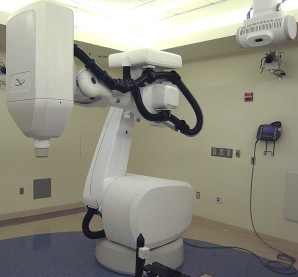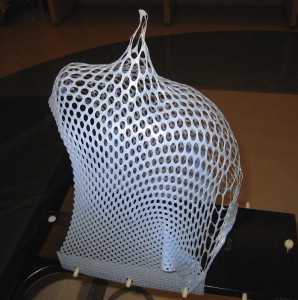Stereotactic radiosurgery is a well-established treatment modality for vestibular schwannoma. Initial reports using single-stage radiosurgery have demonstrated excellent tumor control rates. Many patients now elect to undergo radiosurgery given the potential for tumor control while avoiding the morbidity associated with microsurgical resection. In attempt to improve hearing preservation rates of single-state radiosurgery, staged frame-based radiotherapy using a 12-hour interfraction interval was used at the authors’ institution and has shown a hearing preservation rate of 77% at 2 years of follow-up. With the arrival of the Cyberknife, a frameless, image-guided radiotherapy system, staged stereotactic radiotherapy for vestibular schwannoma became more practical. This article outlines the rationale and treatment protocols developed at Stanford University (California) and reports the authors’ initial experience using the Cyberknife to treat vestibular schwannoma.
Most vestibular schwannomas are benign and slow-growing. Based on that fact, conservative management with serial imaging is a viable alternative. For patients who undergo treatment because of tumor growth, progressive symptoms, or personal preference, options include serial observation, microsurgical resection, fractionated stereotactic radiotherapy, and stereotactic radiosurgery. There remains some debate as to how best to manage these tumors. Historically, vestibular schwannomas have been treated with microsurgical resection. Loss of hearing and facial nerve injury, however, are not uncommon microsurgical complications. Fractionated radiotherapy was used initially as an adjunct to microsurgery in patients who had undergone subtotal resection, and demonstrated the overall effectiveness of radiation for treating vestibular schwannomas. Over the last few decades, stereotactic radiosurgery has emerged as a safe and effective treatment modality for vestibular schwannomas. Owing mainly to the unknown risks of secondary tumors and possible late effects of stereotactic radiation, stereotactic radiosurgery initially was reserved for patients who were poor microsurgical candidates, or as an adjuvant treatment for residual or recurrent tumor. The long-term data of stereotactic radiosurgery now support the efficacy of this treatment modality. Historical reviews also suggest that secondary tumors are rare after radiosurgery. For these reasons, stereotactic radiosurgery has emerged as the preferred treatment modality, as it offers lower morbidity than surgical resection and excellent long-term tumor control.
Traditionally, stereotactic radiosurgery required the use of rigid immobilization using a stereotactic frame to achieve treatment precision and accuracy. The Cyberknife (Accuray, Incorporated, Sunnyvale, California), which was introduced in 1994, does not require the use of rigid immobilization. Although the Cyberknife does not require the use of a stereotactic frame, its accuracy is comparable to frame-based radiosurgery. Additionally, because the Cyberknife does not employ a rigid frame, it is practical to fractionate or stage Cyberknife treatments over several days to decrease the risk of radiation injury to adjacent critical structures, such as the brainstem or cochlea.
The Cyberknife
Stereotactic radiosurgery is a radiation technique that can deliver therapeutic doses of radiation with submillimeter accuracy and a rapid dose fall-off at the periphery of the target. Leksell first conceived the concept of radiosurgery in the 1950s and created the Gamma Knife, which used multiple cobalt sources to treat a target as defined on pretreatment imaging data. Since then, stereotactic radiosurgery has advanced with technologic improvements in computing and imaging. For three decades, stereotactic targeting that required rigid skeletal fixation to provide registration between pretreatment plan and target anatomy was at the center of all radiosurgical systems, especially the gold standard Gamma Knife. In the 1990s, John Adler, however, created the CyberKnife, a robotic frameless radiotherapy system that uses real-time acquisition of the patient’s bony anatomy for image-guidance.
The Cyberknife is a frameless, image-guided, robotic radiotherapy system. Therapeutic radiation is emitted from a compact 6 MV linear accelerator mounted on a robotic arm ( Fig. 1 ). The arm is programmed to move the linear accelerator sequentially through a predetermined series of locations. At each location, radiation is delivered to the target volume. The trajectory and dose delivered at each location are calculated so that their cumulative effect optimizes the coverage of the target volume while minimizing the exposure of adjacent tissues. The Cyberknife can generate beams from more than 1200 directions. This allows for nonisocentric radiation planning that can optimize dose conformality and homogeneity. The need for rigid fixation is circumvented by real-time image guidance. For intracranial targets, patients are relatively immobilized with an Aquaplast mask (WFR/Aquaplast Company, Wyckoff, New Jersey) ( Fig. 2 ). Flat- panel radiograph detectors are mounted on either side of the treatment table and obtain orthogonal radiograph images in real time during the treatment. These images are referenced to digitally reconstructed radiographs (DRRs) that are created from CT datasets obtained during treatment planning. The patient’s position is verified by his or her own bony anatomy. The image guidance software compares differences in three translational and three rotational axes, and adjustments are made with the treatment couch and robotic arm. This process is updated throughout the radiotherapy treatment to maintain accuracy.


Radiosurgery for vestibular schwannoma
Leksell pioneered the use of stereotactic radiosurgery for treating vestibular schwannomas in 1969. He later published his initial experience with vestibular schwannoma radiosurgery using the Gamma Knife in 1971. Since then, stereotactic radiosurgery has proven to be a safe and effective treatment option for managing vestibular schwannomas. Numerous radiosurgical series exist in the literature detailing excellent tumor control rates ranging from 92% to 100% in the first several years after treatment using the Gamma Knife. Additionally, many studies have confirmed excellent longer-term control rates at 5 and 10 years after treatment.
Over the last decade, attention has been directed to improving the hearing preservation rates following radiosurgery and reducing other treatment-related morbidities. Initial radiosurgery series reported hearing preservation rates that ranged from 51% to 60% with significant rates of facial weakness and numbness. Improvements in conformal radiation treatment delivery and use of lower marginal prescription doses, however, have improved steadily the 3- to 5-year hearing preservation rate to between 68% and 77% while also reducing rates of facial weakness and numbness. Despite improved Gamma Knife radiosurgical techniques and lower marginal doses, a recent report has shown a somewhat disappointing 10-year actuarial hearing preservation rate of 44.5%, with hearing loss developing as much as 6 years after treatment.
Studies have demonstrated that the total radiation dose to the cochlea is a critical factor in hearing preservation. Fractionation of the total dose, or staging, however, also may play a fundamental role. Staging radiation treatments long has been proposed as a means to reduce the risk of injury to adjacent critical structures such as the brainstem, cranial nerves, and cochlea. Fractionation of the prescribed dose takes advantage of radiobiologic principles to reduce toxicity and maintain tumor control. The authors’ initial experience with staged frame-based radiotherapy using 21 Gy in three fractions and a 12-hour interfraction interval showed a 77% hearing preservation rate at 2 years. Experience, however, with dose staging using an interfraction interval of 24 hours was limited, as frame-based radiotherapy techniques would require that the patient remain hospitalized while wearing a stereotactic frame continuously over the course of several days.
Based on the proof of principle established in the authors’ staged framed-based study and the introduction of the Cyberknife, it became possible to accurately deliver highly conformal radiation to vestibular schwannomas and fractionate the prescribed dose in an attempt to spare the adjacent brainstem and cochlea. The treatment of the first vestibular schwannoma with the Cyberknife occurred in 1999. Since then, over 350 vestibular schwannomas have been treated at Stanford using the Cyberknife employing a standard 3-day staging protocol.
Radiosurgery for vestibular schwannoma
Leksell pioneered the use of stereotactic radiosurgery for treating vestibular schwannomas in 1969. He later published his initial experience with vestibular schwannoma radiosurgery using the Gamma Knife in 1971. Since then, stereotactic radiosurgery has proven to be a safe and effective treatment option for managing vestibular schwannomas. Numerous radiosurgical series exist in the literature detailing excellent tumor control rates ranging from 92% to 100% in the first several years after treatment using the Gamma Knife. Additionally, many studies have confirmed excellent longer-term control rates at 5 and 10 years after treatment.
Over the last decade, attention has been directed to improving the hearing preservation rates following radiosurgery and reducing other treatment-related morbidities. Initial radiosurgery series reported hearing preservation rates that ranged from 51% to 60% with significant rates of facial weakness and numbness. Improvements in conformal radiation treatment delivery and use of lower marginal prescription doses, however, have improved steadily the 3- to 5-year hearing preservation rate to between 68% and 77% while also reducing rates of facial weakness and numbness. Despite improved Gamma Knife radiosurgical techniques and lower marginal doses, a recent report has shown a somewhat disappointing 10-year actuarial hearing preservation rate of 44.5%, with hearing loss developing as much as 6 years after treatment.
Studies have demonstrated that the total radiation dose to the cochlea is a critical factor in hearing preservation. Fractionation of the total dose, or staging, however, also may play a fundamental role. Staging radiation treatments long has been proposed as a means to reduce the risk of injury to adjacent critical structures such as the brainstem, cranial nerves, and cochlea. Fractionation of the prescribed dose takes advantage of radiobiologic principles to reduce toxicity and maintain tumor control. The authors’ initial experience with staged frame-based radiotherapy using 21 Gy in three fractions and a 12-hour interfraction interval showed a 77% hearing preservation rate at 2 years. Experience, however, with dose staging using an interfraction interval of 24 hours was limited, as frame-based radiotherapy techniques would require that the patient remain hospitalized while wearing a stereotactic frame continuously over the course of several days.
Based on the proof of principle established in the authors’ staged framed-based study and the introduction of the Cyberknife, it became possible to accurately deliver highly conformal radiation to vestibular schwannomas and fractionate the prescribed dose in an attempt to spare the adjacent brainstem and cochlea. The treatment of the first vestibular schwannoma with the Cyberknife occurred in 1999. Since then, over 350 vestibular schwannomas have been treated at Stanford using the Cyberknife employing a standard 3-day staging protocol.
Patient selection
A team that consists of a neurosurgeon or otolaryngologist and a radiation oncologist experienced in the treatment of vestibular schwannomas evaluates all patients treated with Cyberknife radiosurgery. All treatment options, including conservative management and microsurgical resection, are considered by the team.
Cyberknife radiosurgery is offered to patients with unilateral or bilateral vestibular schwannomas that are less than 3 cm in diameter within the cerebellopontine angle. The Cyberknife also can be used to treat residual vestibular schwannomas after a planned subtotal microsurgical resection or those that recur despite apparent gross total removal. Patients demonstrating tumor growth following radiotherapy or radiosurgical treatment also can be considered for retreatment. Retreatment is considered no sooner than 1 year after radiotherapy treatment. Patients who are not microsurgical candidates because of advanced age or other risk factors or patients who do not wish to undergo microsurgical treatment may be candidates for Cyberknife treatment. Additionally, patients who have neurofibromatosis type II (NF2) are also candidates for Cyberknife treatment, although as a group this population does not seem to respond as well to treatment as do patients who have sporadic unilateral tumors.
Stay updated, free articles. Join our Telegram channel

Full access? Get Clinical Tree


